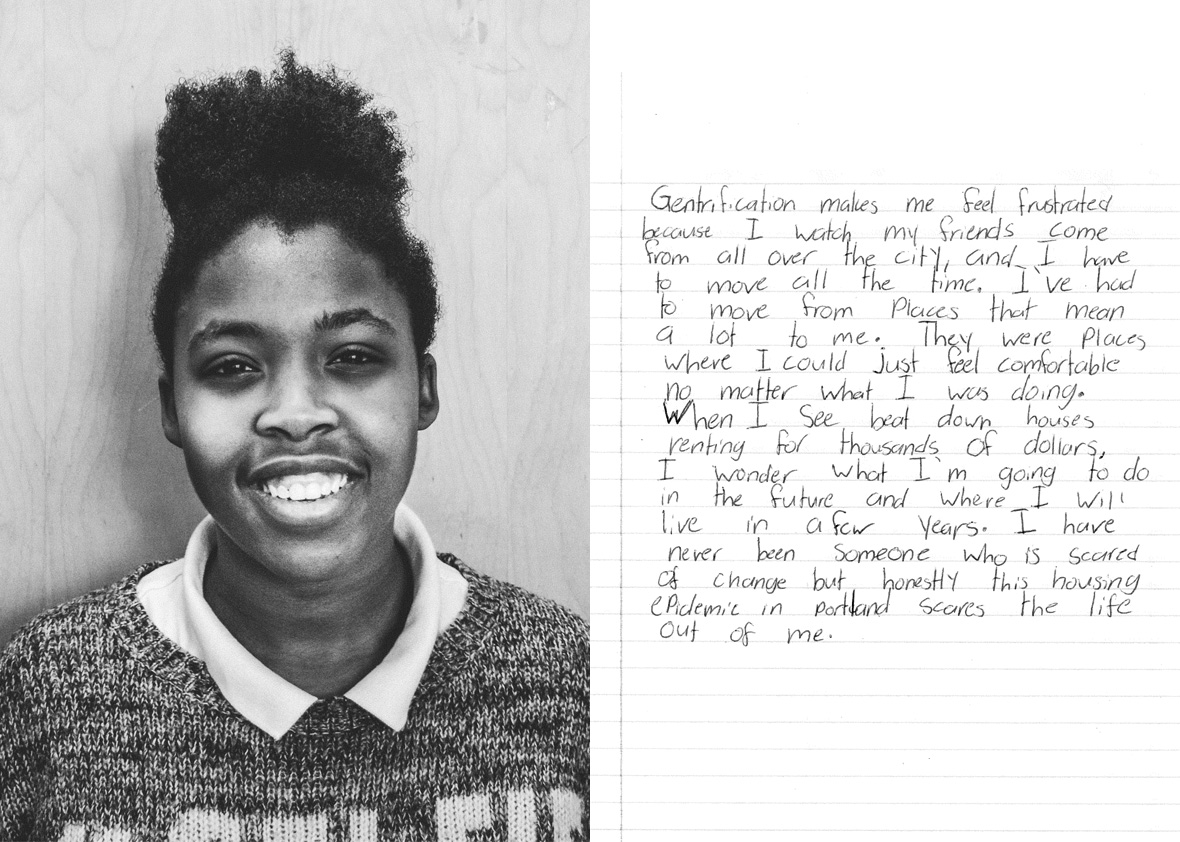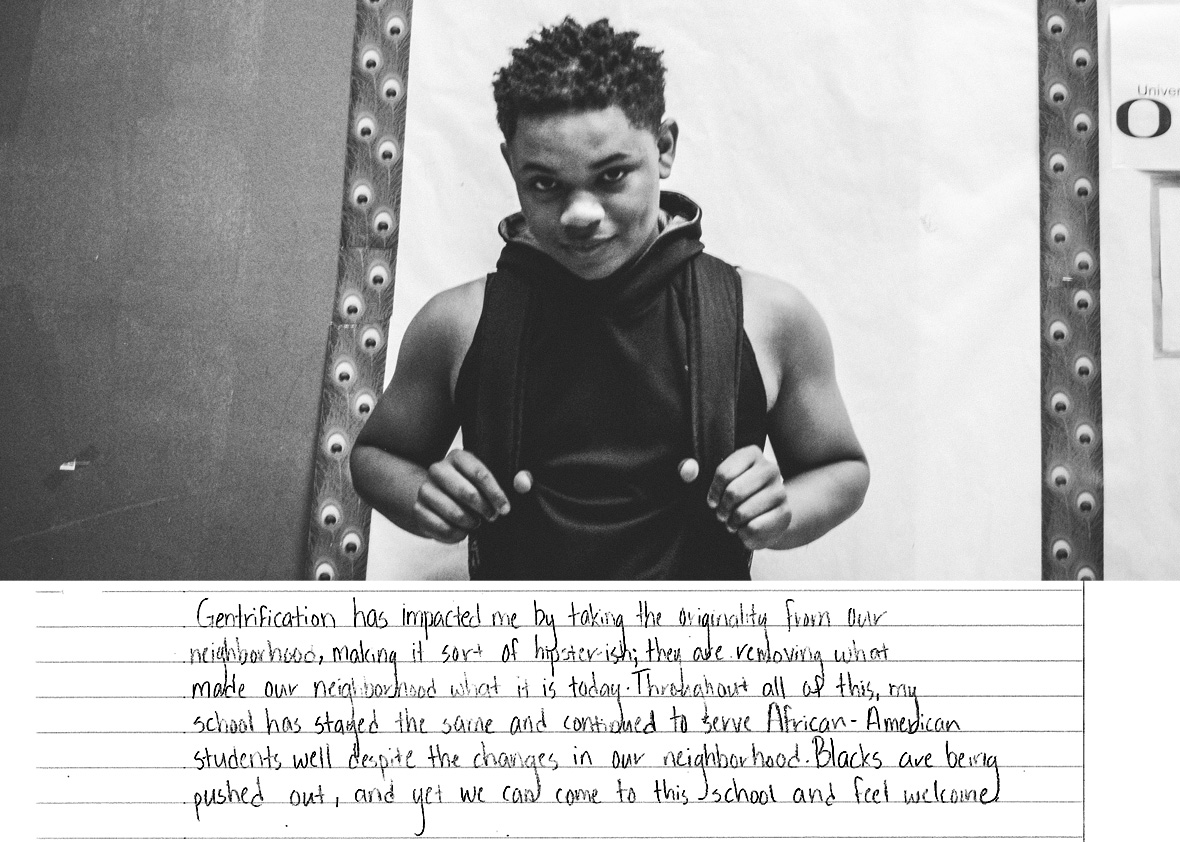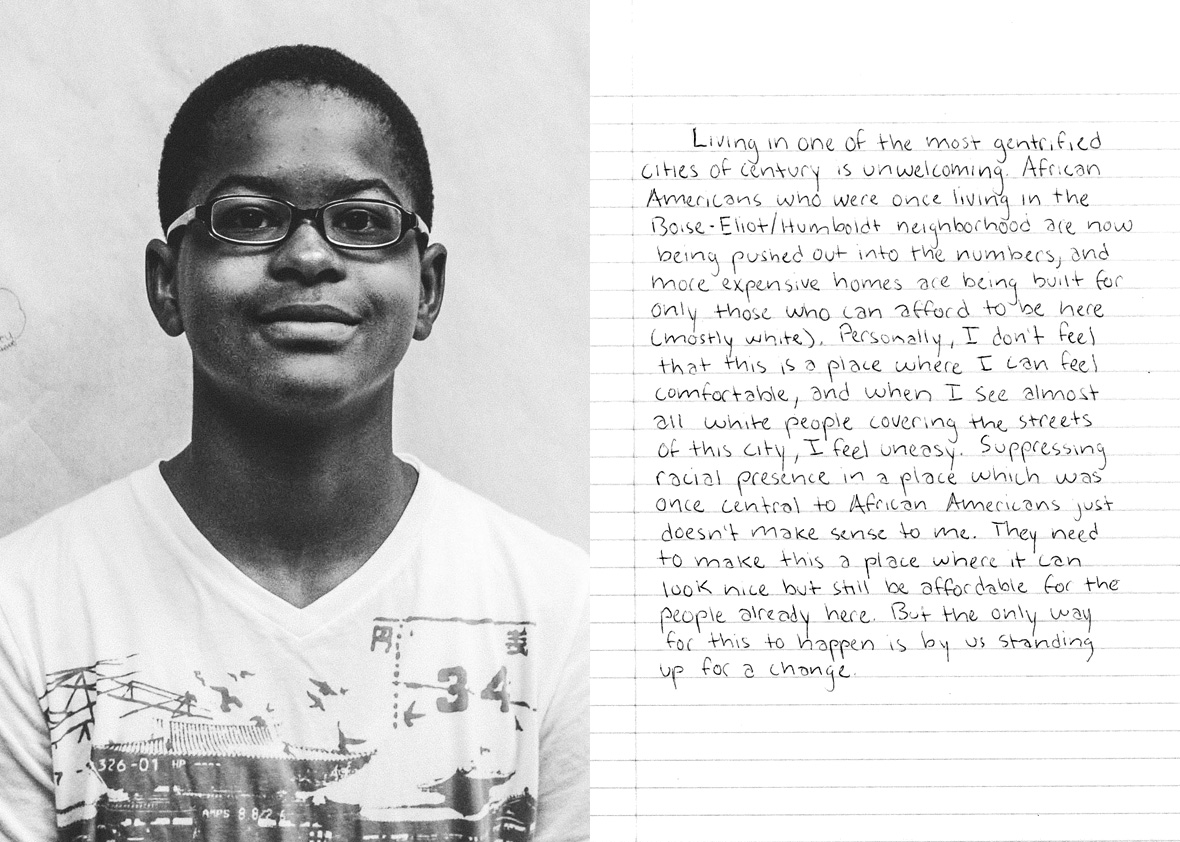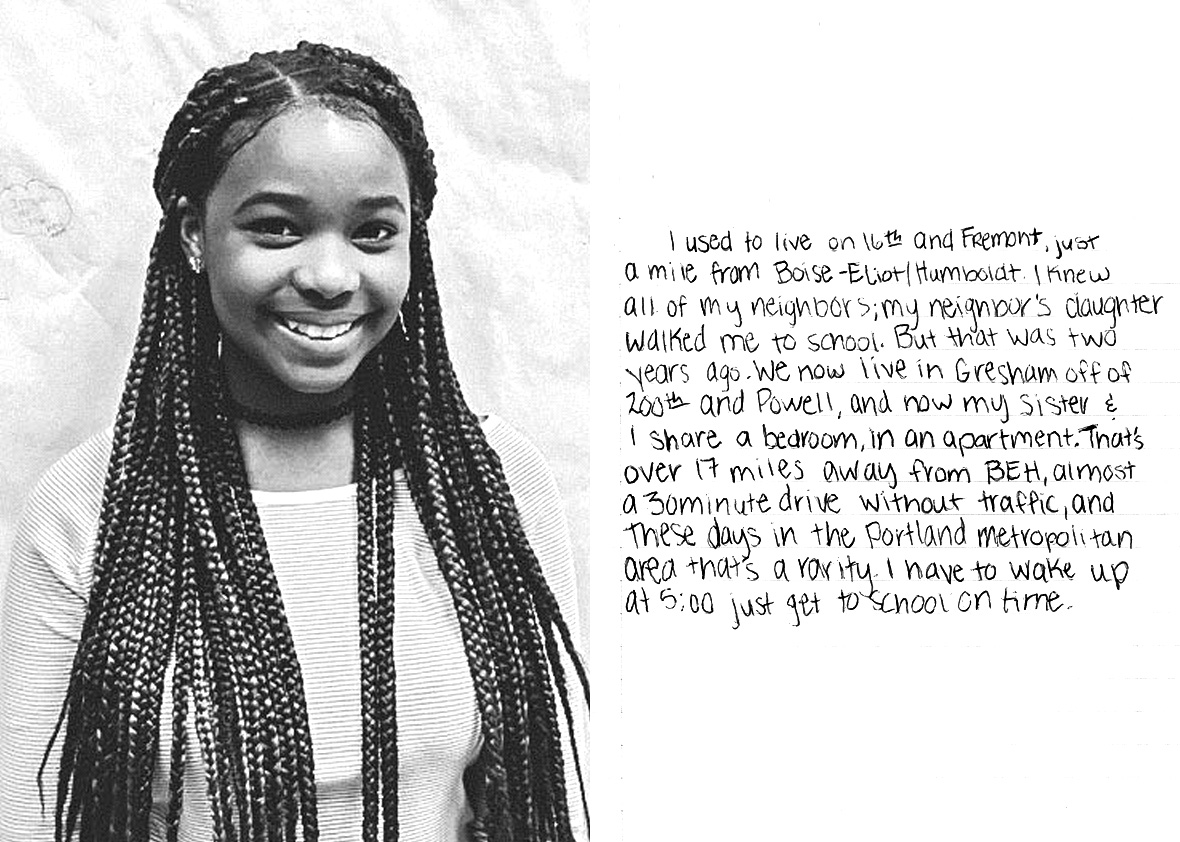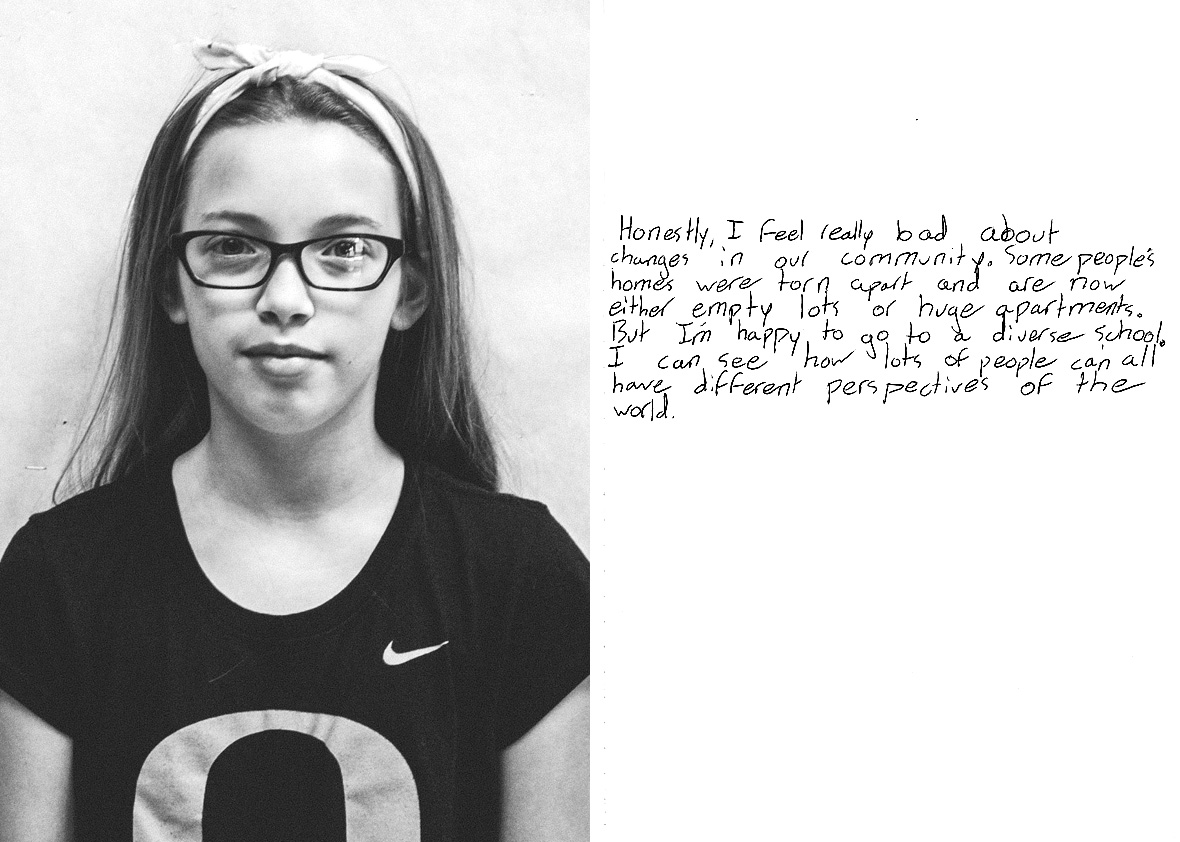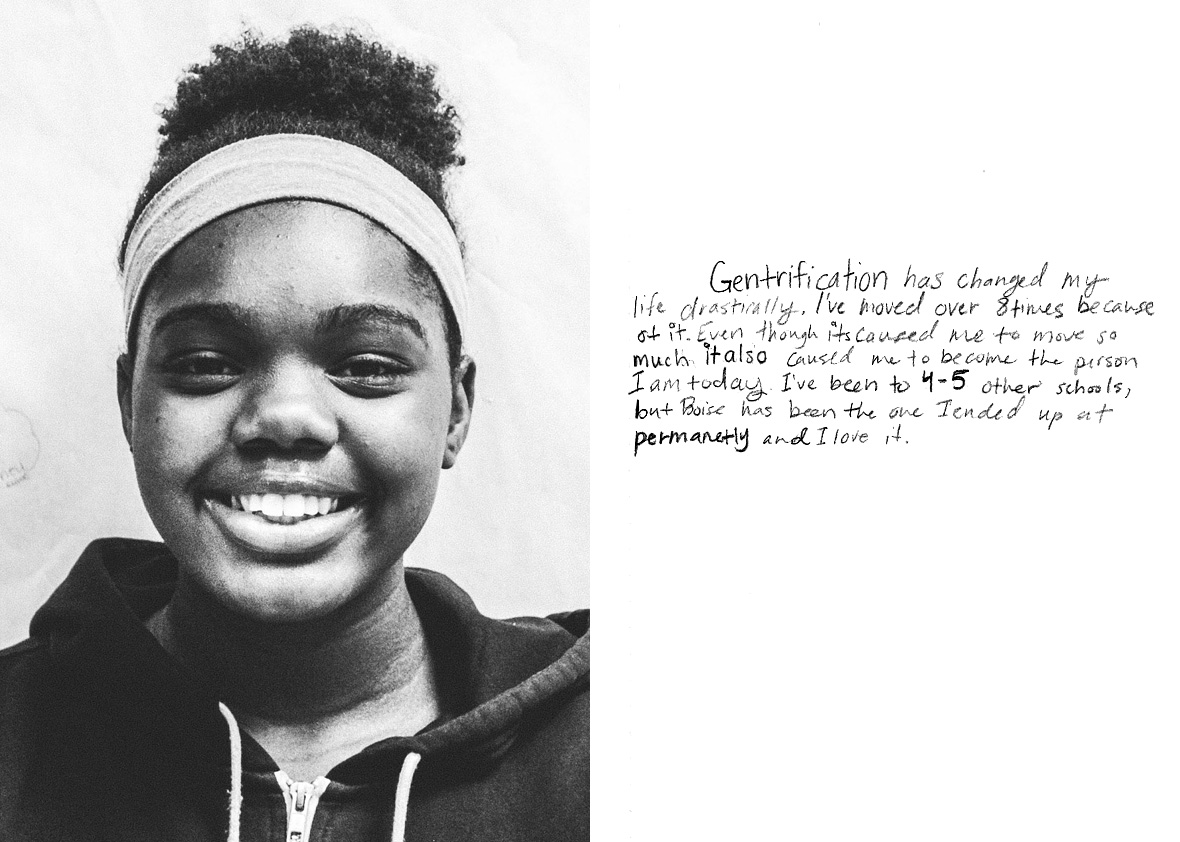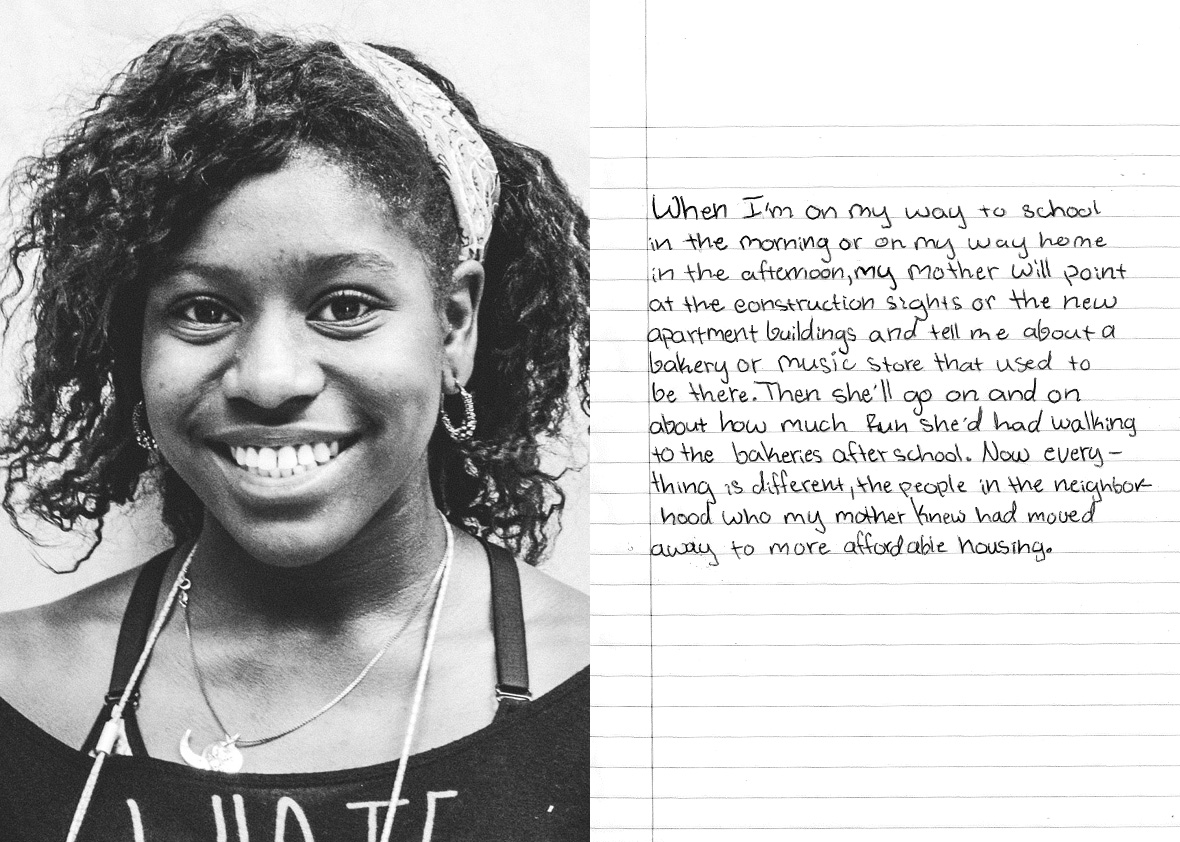When the Neighborhood Gentrifies and the Elementary School Doesn’t
In Portland’s Albina district, a historically black public school is struggling as its area transforms.
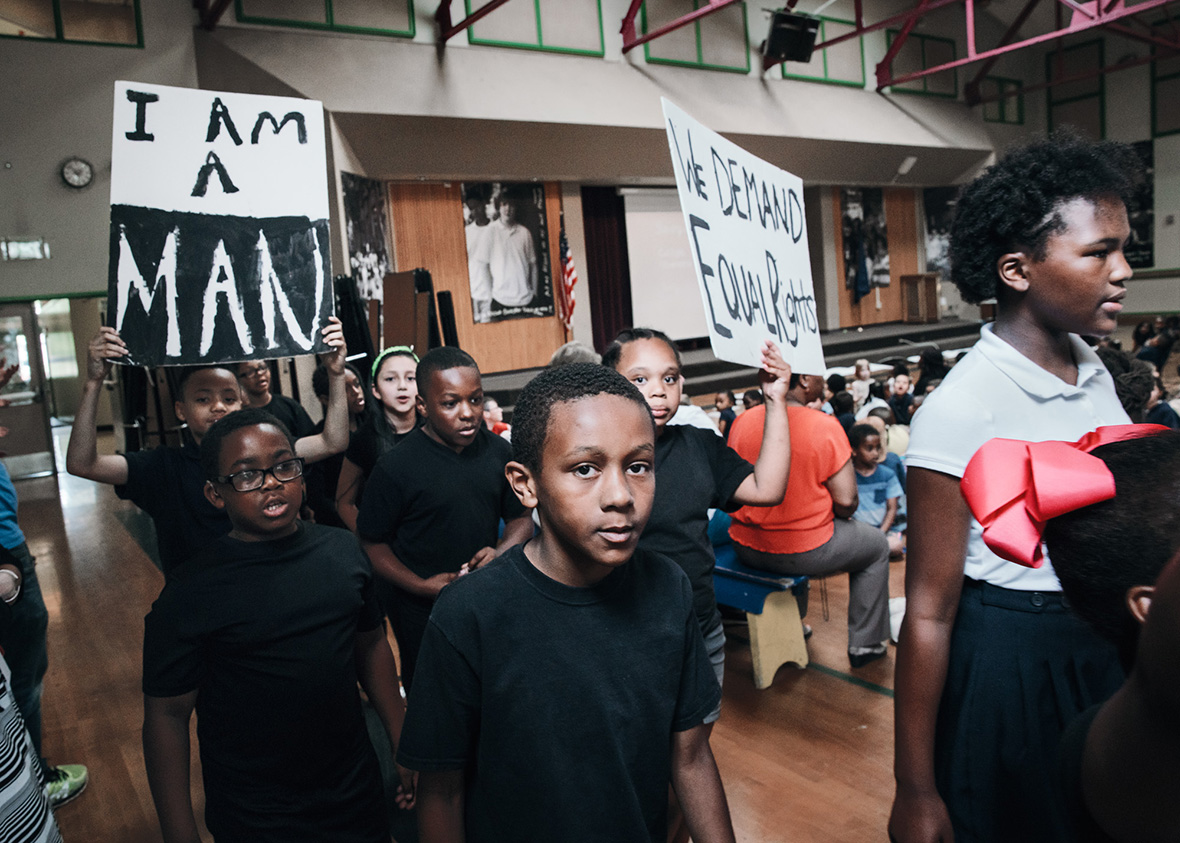
Clayton Cotterell/Slate
PORTLAND, Oregon—Across Portland’s Albina district, chic cafes advertise pour-over coffee and delicacies such as blueberry basil donuts. On Mississippi Street, hollowed-out school buses and roadside stands sell vegan barbecue and bacon jam empanadas. The street signs read “Historic Mississippi,” a nod to the area’s century-old roots, but it’s increasingly difficult to find spots that don’t evoke the decidedly ahistoric hipster vibe that now makes Portland famous.
One notable exception is the neighborhood’s pre-K–8 school, Boise-Eliot/Humboldt—known as Boise for short. Sandwiched between a block of newly renovated bungalows and a strip mall with a yoga studio and a combo bar and laundromat, the two-story red brick building hasn’t changed much in decades. Unlike the neighborhood’s new residents, a majority of its students are black and low-income. Many of their families have been priced out of the Albina area and relocated to outskirts of Portland, a move known as going “out to the numbers” because of those areas’ numbered streets. So the students take public transportation to attend Boise, a revered institution in Portland’s black community. Most newly arrived white families, meanwhile, transfer their children out of Boise into schools that they consider better—and which are definitely whiter.
When neighborhoods gentrify, schools often don’t follow—at least not nearly as quickly. It’s a phenomenon playing out across America as middle-class white families move into urban neighborhoods that real estate agents might have once called “undesirable.” Think Harlem in Manhattan, Oak Cliff in Dallas, the Bywater in New Orleans, the South Loop in Chicago, or the Mission District in San Francisco. They may be hip destinations with attractive amenities, but most of their public schools don’t get the same love from new arrivals. The problem is particularly acute in Portland, which is already the whitest big city in America and growing whiter.
The trend deprives schools like Boise of some of the benefits that neighborhood schools often enjoy: Even the most dedicated families increasingly live too far away to meaningfully participate in the school’s activities and community. It’s a challenge Boise’s principal, Kevin Bacon, who is black, grapples with every day. If the school succeeds in recruiting more white families to Boise, the wealthier students would likely mean higher test scores and more resources—but black families would further lose their foothold in Boise and the neighborhood at large. On the other hand, if Bacon proactively strives to maintain Boise’s focus on serving black students, the disconnect and distrust between the neighborhood and school may only deepen. Neither path may be ideal; finding some kind of balance might be impossible.
“It’s like overseeing a funeral,” Bacon says.
* * *
Generations of poorly conceived and racist housing, busing, and school policies have led to the dilemma now faced by Boise.
Despite the changes in the area, the student body remains a hair under 60 percent black and only 15 percent white. That’s almost opposite of the surrounding neighborhood, which according to the 2010 census is 63 percent white and less than 20 percent black (down from more than 50 percent black in the 1980s, and almost entirely black in the 1960s). School staff say the neighborhood has grown even whiter in the past six years, with the school demographics changing at a much slower rate.
Portland Public Schools previously allowed parents to enter their children into a lottery and select schools of their choice. Now, the district relies on a petition system that allows students to transfer with district approval—a requirement it said would prevent families from fleeing (mostly minority) schools with low enrollment. But the petition policy is lax. Parents affected by the system say they view it as an extra step, but not one that prevents them from getting their children into the schools they want.
This system allows many black students who’ve moved away to petition to attend Boise, but Bacon says even more simply fake their addresses—listing the home of an aunt or a grandmother who still lives near the school. “This school has always served Portland’s black community. They have relationships here—trust,” says Bacon. “The school has delivered for their relatives, and they want that for their kids.”
Portland Students Speak on Gentrification:
Like all of America, Oregon has a racist history, having banned black people from working, living, or owning property in the state until 1926. Afterward, blatantly racist housing practices, such as redlining, forced the few black residents into certain areas. The city and real estate agents, responding to the demands of white residents, refused to sell or rent homes to black families elsewhere, saying they’d decrease home values, says Portland State University urban studies professor Karen Gibson, who published a study on the city’s neglect and destruction of the area titled “Bleeding Albina.”
After World War II, when black families who’d moved to Portland for jobs on air bases were looking for housing, many of them ended up in Vanport—a housing project built just outside of city limits, intentionally separated from the rest of Portland. A 1947 Oregon Journal article described Vanport this way: “The colored people have to live somewhere, and whether the Northwesterners like it or not, they are here to stay. It is almost a physical impossibility to throw 20,000 people out on the street.”
But that’s exactly what happened in 1948, when Vanport flooded. Because the neighborhood was built on marshland, its safety depended on dikes officials promised would hold. They didn’t. The housing project, built of fiberboard on wooden blocks, literally washed away. Five thousand families were left homeless. One thousand of them were black.
What’s known simply as “the flood” shaped institutions like Boise. After being washed out of Vanport, the only place the city allowed black residents to go was the Albina district, an area including the Boise, Eliot, and Humboldt neighborhoods.
By the 1960s, 80 percent of Albina’s residents were black. Albina became the center of black life in Portland—until the city systematically shredded its fabric. In the 1960s, Interstate 5 tore through Albina, forcing out residents. In the 1970s, Portland declared many black-owned homes and business blighted and shuttered them, driving people out. In the years following, the Black United Front’s Portland chapter fought for police accountability, a greater focus on institutional racism, and an end to busing black children to white schools. Its members wanted equal educational opportunities in their own neighborhoods, threatening a boycott in 1979 if the school district didn’t allocate more funding and hire more black teachers to teach at schools in Albina such as Boise Elementary. When Eliot Elementary closed in the early 1980s to accommodate a middle school in the neighborhood and Humboldt School closed in 2012—both due to dwindling enrollment numbers—their students, and names, went to Boise.
Black families, even those who live far away, continue to enroll their children at Boise because it is where they have always gone. Every black parent I interviewed for this story had also gone to the school or had a spouse who had. Some of their parents had also attended. “My husband went here,” said Dimitri Brown, whose daughter Peyton is in first grade. “He wanted her to come here too. It has a sense of family.”
Given the city’s history of mistreating and even expelling black residents and institutions, it’s no surprise that Boise’s community now feels that the school’s future is precarious.
* * *
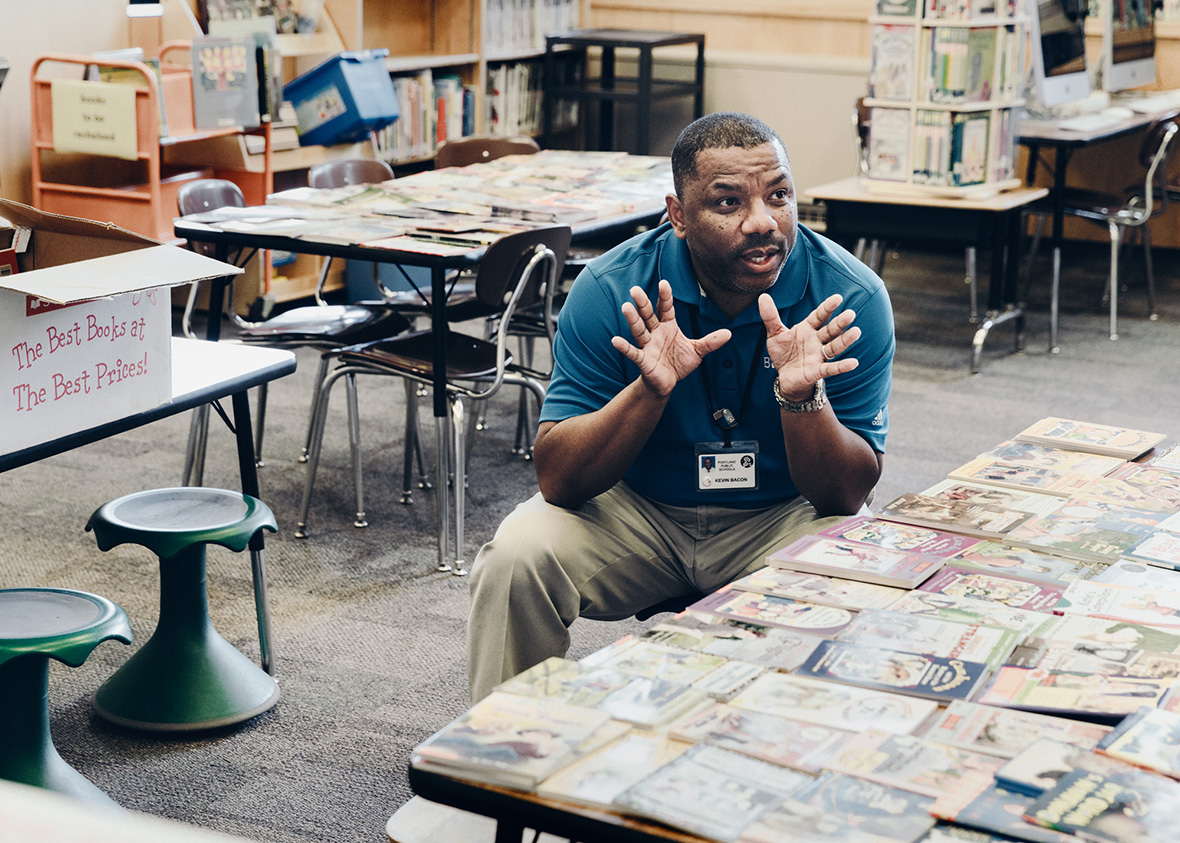
Clayton Cotterell/Slate
It’s only Bacon’s third year as Boise’s principal, but he’s already become a beloved figure. On a drizzly January morning, a tall seventh-grader walked past him in the hallway. “Mr. Bacon, can I have a hug?” she said, shoulders slouched. Bacon obliged. That afternoon, he donned a yellow apron in the school’s cafeteria and handed out lunch to elementary school students.
Bacon has spent his entire career working as an educator in and around Portland. He began teaching in the mid-’80s and became vice principal of Albina’s Jefferson High School a decade later. Many of his students from Jefferson are now parents of his students at Boise.
But the same families who grew up in the neighborhood can’t afford to live here now. Bacon says the student body’s homelessness rate has been ticking upward, and others have long commutes from the outskirts of the city. The travel means students often can’t stay for after-school programs or that parents pick their kids up early to avoid traffic. The students who rely on public buses often face an hour of commuting each way. “When an older sibling who comes to school on the bus is sick, that means the younger sibling doesn’t come to school either,” says Bacon. “Kids also just don’t sleep enough. They get up early to get here and then get home late.”
Bacon laments that the neighborhood’s new residents haven’t embraced Boise. It used to be a source of pride for the area, which had long battled for a quality school to call its own. That sense of ownership is fraying.
He knows his school will become whiter, though that will take time. In this year’s parent meeting for incoming kindergarteners, he was surprised at the number of white families. He says Boise will “be here for whoever wants to come” and that he’s tried to embrace the white families who have already enrolled. “I’m not going to spend too much time trying to force white people to come that might not want to come, but we’ll be open to their questions and sell the best parts of the school like we always do,” he says.
There are plenty of reasons why white, more affluent parents don’t send their children to Boise. They might cite the test scores or the draw of creative instruction at charter schools. But much of it involves internalized racism—racism that is amplified by ineffectual school district policies.
White families often transfer their children to Trillium Charter, a high-achieving school that’s less than 10 minutes away and 82 percent white. They can also send their kids to Portland magnet schools if their test scores are high enough or use the petition system to transfer to schools closer to their jobs. According to district figures, only half of neighborhood children attend Boise. Staff say many of these are black families who’ve long attended the school and have managed to stay in the neighborhood. The black students who fake their addresses, indicating they still live in neighborhood boundaries, also skew the numbers.
“For white families, exclusivity breeds a certain thinking,” says Evelyn Flowers, Boise’s assistant principal, who is black. “If it’s white, it’s good. If it’s black, it’s less than. Not bad, less than.”
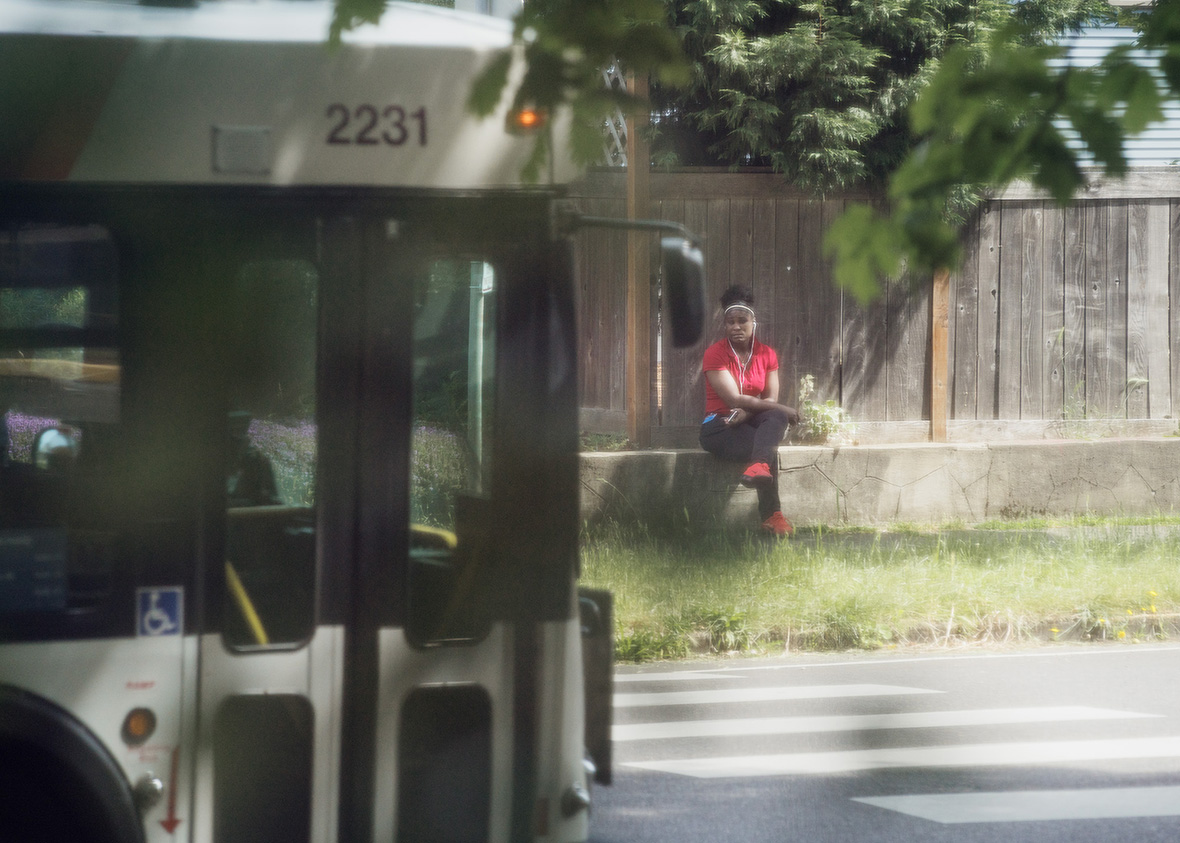
Clayton Cotterell/Slate
But some white families are pushing past the stereotypes. Jill Zahm sends her son, Nathan, to kindergarten at Boise.
“I know I am the face of gentrification in this neighborhood,” says Zahm, who moved there a decade ago. Back then, Zahm’s friends in the area viewed it as a “given” they’d enter their children in the lottery, going for better schools. But that’s no longer an option. The year before Zahm needed to select a school for Nathan, Portland switched away from the lottery system.
While Zahm could have petitioned, she chose Boise. Friends and family questioned her decision. She disagreed and wishes more people would do the same. “I feel more like I belong because I sent Nathan here,” she says, adding that she believes in neighborhood schools on a “guttural” level. “I want to take care of the neighborhood I live in.”
But the switch from the lottery to the petition system has barely changed the demographics of Boise. Nathan’s kindergarten class is 18 percent white, only 2 percentage points whiter than the school overall. The district doesn’t know what to do about it—or if anything should be done. On one hand, the neglect of the school by the area’s newly arrived parents is frustrating. On the other, forcing new residents to send their children to Boise would force out black families who have sent their children to the school for decades and now petition their kids in.
The district has heard from housing advocacy organizations and participated in culturally specific listening sessions, all in an effort to better understand the experiences of those being displaced from the neighborhood, says Judy Brennan, director of enrollment for Portland Public Schools. For this reason, PPS accepts two-thirds of petitions for transfer back into Boise. The district is banned from looking at race as a factor for enrollment, so students are accepted if their families have a history of attending the school or if the students might have relatives close by who have offered to pick them up. Brennan knows these things are often simply a way to get at race indirectly.
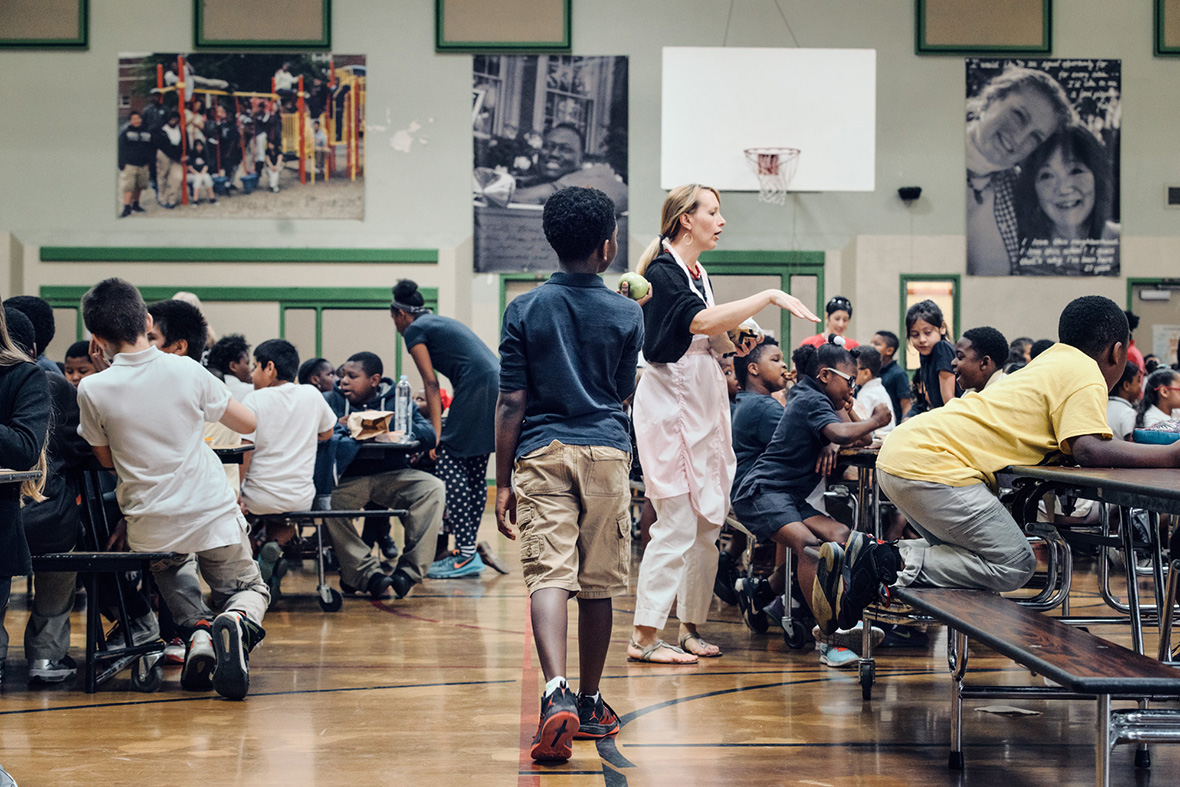
Clayton Cotterell/Slate
“We are going to remain race-conscious even if we have to remain race-neutral,” she says. “We can’t decide where people live, but we can decide if where people live decides where they get to go to school.”
Brennan knows many people fake their addresses—they’ve told her so. One woman in a 2014 listening session told the board she used her mother’s address to get her autistic son into Boise, despite the 45-minute drive.
“Their needs as people of color have been respected there,” Brennan says, adding that the white people who’ve moved into the neighborhood don’t have the same sense of ownership over the school. “They liked the old traditional house, but not the school that’s with it.”
* * *
While many white residents of the neighborhood look askance at Boise, some black families increasingly worry the school is not serving their interests, either.
Boise families have been comfortable with Bacon, but he’s faced pushback recently from parents who are frustrated by the school’s continually low test scores—just 50 percent of students passed last year’s tests, only a slight improvement over previous years. “I’m angry, too,” says Bacon. “But I think we are onto something with this school.”
Bacon rejects the idea that test scores measure a school’s success. No school he is aware of has improved its test scores without radical changes, like becoming a charter or a major demographic shift. “Seven years from now, if you come back, this school is going to be more white, and the test scores are going to be better, and all of a sudden I’m going to be a magician,” he says, laughing.
That doesn’t mean he’s doing nothing. Since he started, his school has embraced a STEAM curriculum—science, technology, engineering, art, and math—championed by the Rhode Island School of Design, which seeks to integrate art and design into a math and science curriculum. So, instead of simply learning about circuits in January, middle schoolers built a moving sculpture that either lit up or moved (or both). Kindergarteners and first-graders were invited to see the sculptures, while the older students explained how they worked.
These hands-on activities are what Bacon hopes will turn things around for students: Allowing them to conquer the “experience gap” inherent to tests that allows richer, whiter students to score higher.
“We have a lot of students in this school who have never been to the Oregon coast. So if the question is built around a beach, the kids aren’t going to understand that,” he says.
To fix this, he says, Boise takes more field trips than any other school in the district. Its library has salmon eggs growing in a tank, and students participate in monthly design competitions and work with artists-in-residence at the school. In December, students built catapults and competed by flinging objects across the playground.
Still, some parents aren’t seeing the kind of progress they expect. One parent, Karanja Crews, has begun to mobilize other parents to fight for more culturally relevant teaching. “This school is 60 percent African American, but the curriculum does not reflect that,” says Crews, who Bacon says has been known to sit in the back of his first-grade daughter’s classroom taking notes on whether the teaching is aligned with the students’ culture.
Crews was a teacher in suburban Portland and now runs Teaching With Purpose, which puts on seminars and conferences on “culturally relevant” teaching. In January, he organized a town hall meeting at Boise aimed at addressing how the school—and Portland as a whole—could better serve black children.
At the end of the meeting, parents were invited to voice their concerns and make suggestions. One said she was concerned with the way Boise was perceived. “Someone said to me, ‘You send your child there? That’s a thug school,’ ” she said, to gasps in the audience. “My child was in fifth grade at the time. She was labeling my child.”
Another parent, frustrated with a disciplinary process she said singled out black children, complained teachers prevented her child from singing and dancing in class. Another called on teachers to express more personal concern for the children. “Our children know when you believe in them,” she said.
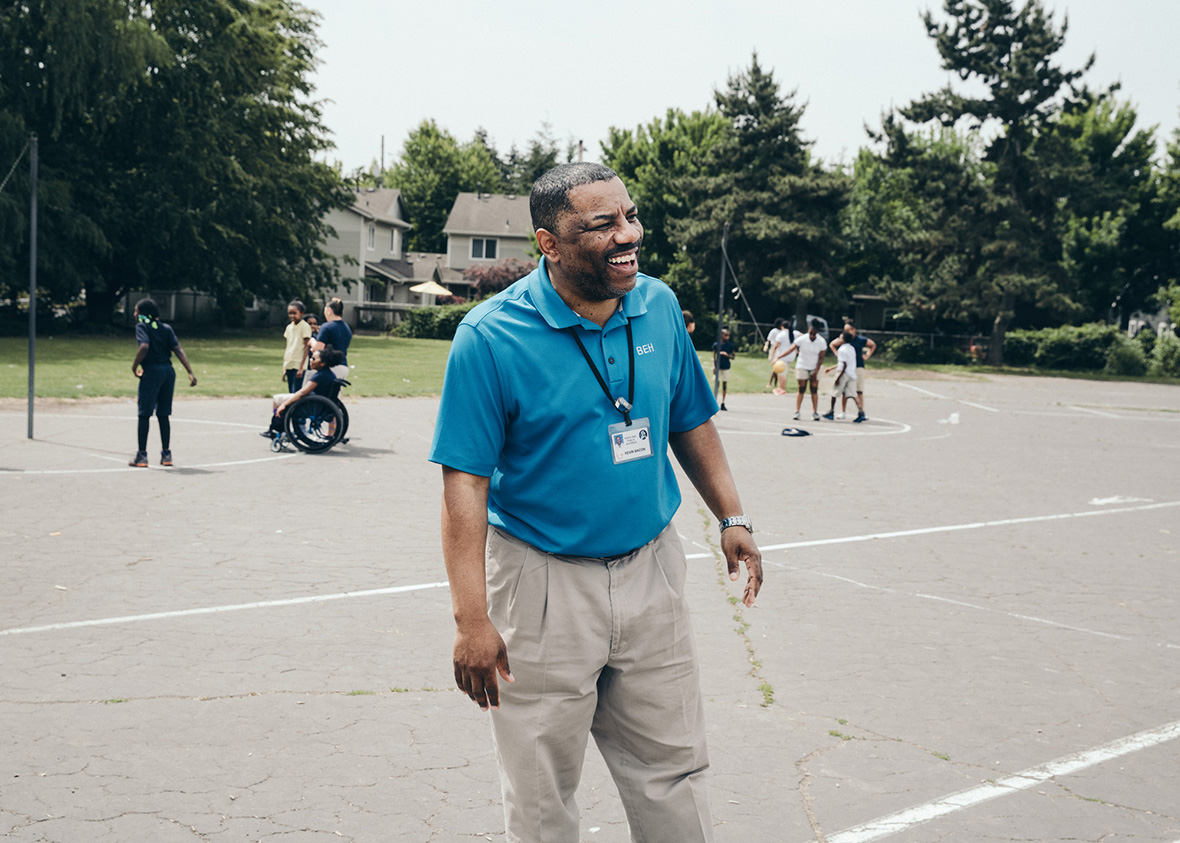
Clayton Cotterell/Slate
Bacon has welcomed this dissent. “You have to run toward problems,” he says. More than half an hour after the town hall ended, late on a Friday night, Bacon and Crews stood on the sidewalk in front of Boise, talking about possible next steps.
Now, a core group of parents and teachers have begun implementing some of the ideas. Parents will now sit in on interviews with potential teachers, and the group is working together to better facilitate communication between family and staff.
But while Bacon is open to the criticism, he’s concerned that the negativity will discourage Boise’s teachers, who, because of the high needs of Boise’s students, are already working harder than teachers elsewhere. He hopes parents see the progress they’ve already made.
Boise has severely clamped down on suspensions and now only removes children in extreme circumstances—a change Bacon says is integral to moving toward a more productive disciplinary system. The year before he arrived, Boise suspended 86 students. In his first year, they’d cut that down to 60. Last year the number was 19.
“Ultimately, it’s relationships,” he says. “Kids need somebody to disappoint.”
But what’s resonated with him most from the town hall was the pessimism around test scores—the disproportionate impact they have on the perception of the school and its students, despite what he believes are their almost total inability to judge the effectiveness of instruction.
“Last night might have clarified that for me. I really came away with the idea that I have to speak up about this test,” he says, adding that after 30 years in the field he feels compelled to shove off any tiredness to make this his mission. He thinks he has five or six more years to dedicate to Portland, and he wants to spend them showing the neighborhood that tests scores aren’t everything. Boise-Eliot/Humbolt has a lot to offer that tests simply cannot measure.
“There’s a little bit of burnout,” Bacon says, an observation that could apply to himself or to his school. “But the light’s not totally out.”
Tomorrow’s Test is a weeklong series looking at the challenges, tensions, and opportunities as the United States shifts to a majority-minority student population in its public schools—a milestone the country as a whole will reach within the next generation. It is a collaboration with the Teacher Project at Columbia Journalism School, a nonprofit education reporting fellowship.
Read more from Tomorrow’s Test.

